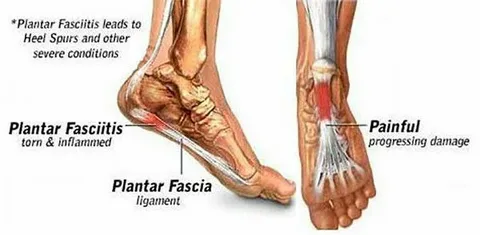Stepping out of bed and feeling that sudden, piercing ache under the heel can be startling. Many people assume it’s plantar fasciitis, but heel pain has multiple causes that often mimic one another. Understanding the subtle differences can help identify when it’s time to see a plantar fasciitis doctor or seek guidance from a plantar fasciitis specialist for accurate treatment and faster recovery.
Morning Step Pain Often Points to Plantar Tissue Strain
Pain that strikes with the first step in the morning is a hallmark sign of plantar fasciitis. This occurs because the thick band of tissue along the bottom of the foot, known as the plantar fascia, tightens during rest. As soon as weight is applied after sleep or prolonged sitting, the tension suddenly stretches, triggering sharp discomfort. Other heel conditions, such as arthritis or nerve entrapment, rarely follow this pattern. A plantar fasciitis doctor often notes that this specific “first-step” pain helps differentiate plantar fasciitis from joint-related inflammation. Once the fascia warms and elongates through mild movement, the ache typically subsides, which is rarely seen in tendon or nerve disorders.
Aching Along the Arch Separates Fascia Stress from Joint Issues
Pain that spreads along the foot’s arch signals stress to the plantar fascia rather than problems within the joints. The fascia acts as a shock absorber, supporting the arch during every stride. Repetitive strain or tight calf muscles cause microtears along this band, creating arch tenderness that radiates toward the heel.
Joint-related pain, however, usually appears deeper and may involve swelling or stiffness around the ankle. A plantar fasciitis specialist can use palpation and range-of-motion tests to pinpoint the exact tissue involved. Fascia-related discomfort often worsens after long periods of standing but improves once pressure is removed—unlike arthritis, which tends to intensify with continuous use.
Sharp Heel Pressure Contrasts with Diffuse Achilles Discomfort
A distinct, stabbing pain directly beneath the heel often signals plantar fasciitis, while soreness spreading up the back of the heel typically stems from Achilles tendon issues. The plantar fascia anchors at the heel bone, and micro-inflammation at that insertion point produces a sensation like stepping on a small stone.
Achilles-related discomfort feels broader and may tighten with ankle motion. The location of tenderness is a key indicator for a plantar fasciitis doctor diagnosing heel pain. In cases of plantar fasciitis, pressing the underside of the heel triggers pinpoint soreness, while tendon injuries respond more along the upper or posterior heel region.
Swelling near the Heel Pad Signals Bursitis Rather than Fascia Tension
Heel bursitis develops when the small fluid-filled sacs that cushion the heel become inflamed. This condition causes noticeable puffiness or warmth around the heel pad, often accompanied by tenderness when pressing from the sides rather than the bottom. Such symptoms distinguish it from plantar fascia irritation, which is typically deeper and more localized.
Patients with bursitis often report a dull ache that worsens after sitting or wearing tight shoes. A plantar fasciitis specialist can recognize the difference through imaging or palpation tests. The presence of swelling without arch pain usually indicates bursitis rather than fascia inflammation, guiding treatment toward rest, cushioning, and footwear adjustments instead of fascia-specific therapy.
Pain That Eases with Movement Differs from Constant Tendon Irritation
Plantar fasciitis pain commonly fades as the day progresses and the tissue stretches through walking. This improvement pattern helps distinguish it from chronic tendon conditions, where discomfort persists or even worsens with movement. The fascia benefits from gradual flexibility, while tendons react to repetitive strain.
In many cases, patients assume ongoing heel pain after exercise is plantar fasciitis, when it may actually involve the posterior tibial or peroneal tendons. A plantar fasciitis doctor evaluates gait mechanics and muscle function to determine whether repetitive motion or improper footwear contributes to the pain. Recognizing these nuances ensures that strengthening or orthotic strategies target the right area.
Heel Tenderness Localized at One Spot Suggests Fascia Involvement
Unlike diffuse soreness caused by arthritis or nerve pain, plantar fasciitis creates a specific focal point of tenderness near the heel’s center. Pressing this area often reproduces the exact discomfort felt during walking, confirming the fascia’s role in the problem. The inflamed portion is typically just in front of where the heel meets the arch.
Conditions like tarsal tunnel syndrome or heel spurs produce broader or radiating pain. A plantar fasciitis specialist uses pinpoint palpation to locate the pain’s origin. The precise nature of fascia tenderness often helps guide ultrasound therapy, stretching routines, or orthotic support aimed directly at the affected zone.
Stiffness After Rest Distinguishes Chronic Fascia Inflammation
Persistent stiffness after periods of inactivity is another defining trait of plantar fasciitis. The fascia loses flexibility overnight or after long hours of sitting, creating tension that must be stretched out before walking comfortably again. This stiffness signals chronic inflammation, where small tears repeatedly heal and re-irritate.
Other heel-related conditions, such as nerve entrapment or bursitis, do not typically produce this stiff, stretching pain after rest. A plantar fasciitis doctor often recommends targeted morning stretches and night splints to maintain tissue flexibility. Recognizing this stiffness pattern early allows patients to manage symptoms before long-term scarring develops.
Radiating Soreness Toward the Calf Indicates Tendon or Nerve Origin
Pain that creeps up the back of the leg or radiates toward the calf often points away from the plantar fascia. Such discomfort usually involves the Achilles tendon, posterior tibial tendon, or sciatic nerve pathways rather than the heel’s connective tissue. These cases may feel like a pulling sensation or burning ache rather than localized soreness.
A plantar fasciitis specialist can test muscle resistance and nerve sensitivity to identify the source of radiation. In true plantar fasciitis, pain rarely moves upward past the heel, remaining isolated beneath the arch or along the fascia. Recognizing this difference prevents misdiagnosis and ensures that treatment targets the correct structure rather than relying on ineffective fascia-based therapy.


